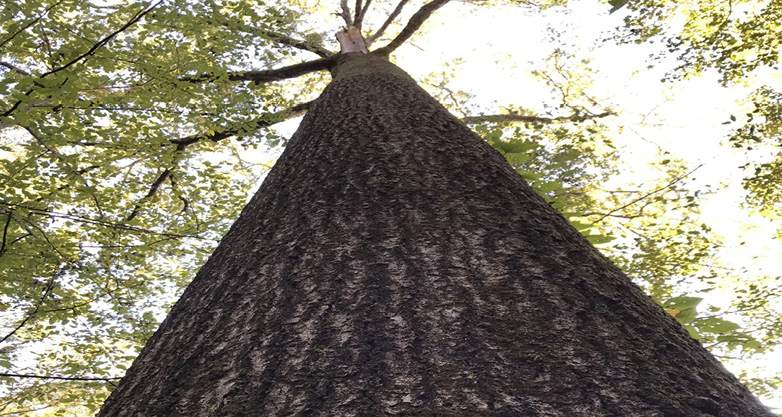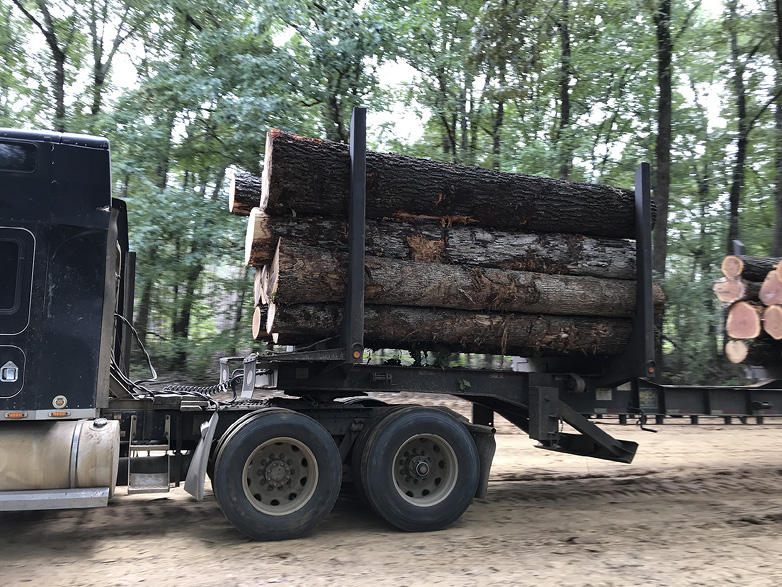Hardwood Timber Volume-to-Weight Conversions


This publication is intended to complement Mississippi State University Extension Publication 2244 Pine Timber Volume-to-Weight Conversions by presenting similar information for hardwood species. As such, P2244 may be used for background information regarding reasoning and purpose for converting timber volumes to weight. Remember that the volume-to-ton conversions presented here are averages and are intended for use only in estimations and guidelines. Note that considerable variation exists both in estimation of volumes and weights of hardwood logs as well as within any individual species or among different species.
Several factors increase the variability in hardwood timber volume-to-weight conversions:
Log diameter is extremely influential in variance among logs. Log rules typically underestimate lumber yield in small-diameter logs and can overestimate yield in larger logs.
Individual log density can increase variability, with logs of the same diameter and species ranging as much as 40 percent in some cases.
The position of a log in a trunk can influence wood density, as well. Density can increase with bole height, and logs positioned further up the trunk may weigh more per board foot. On the other hand, there can be substantial taper in butt logs resulting in more weight for a calculated volume due to a much smaller scaling diameter at the end of the log.
The amount of time between felling and weighing logs is important; as logs dry, weight per board foot decreases.
Different species produce wood with different densities and typical moisture content. Denser woody species typically have lower moisture levels and log weights that do not vary as much as they dry.
Growing site differences can influence log weight due to differences in the types of wood (tension and compression) as well as nutritive influence on multiple wood characteristics.
Genetics play an important role, with individuals of the same species having different wood densities.
The season of the year can be influential, with logs often weighing slightly more in the spring and slightly less in the summer compared to the rest of the year.
Increases and decreases in growth rate can also result in varying wood density, as changes in spring and summer wood proportion can be associated with differing wood density.
Volume-to-Ton Conversions
Like pine, hardwood timber is divided into different product types. However, only two product types are used in differentiating hardwood classes: pulpwood and sawtimber (Table 1). Hardwood pulpwood is usually measured in merchantable feet and ranges upward from 8 inches DBH (diameter at breast height; 4.5 feet above ground level). Historically, hardwood pulpwood volume-to-weight conversion was established at 2.7 tons per cord for soft hardwood species, 2.8 tons per cord for mixed hardwood species, and 2.9 tons per cord for hard hardwood species (MS Code § 75-27-39). These conversion factors can be used with methodology detailed in P2244 for quick “cords-to-tons” estimation of hardwood pulpwood.
Table 1. Volume-to-ton conversions for mixed hardwood products in Mississippi. The weight of wood can vary from tree to tree, so use these conversions as estimates and guidelines only.
|
Product¹ |
Average DBH² |
Tons per Unit Volume Conversion³ |
|---|---|---|
|
Pulpwood |
|
2.7 tons per cord for soft hardwood species 2.8 tons per cord for mixed hardwood species 2.9 tons per cord for hard hardwood species |
|
Sawtimber (when only DBH is known) |
14 |
12.1 tons per MBF |
|
|
16 |
10.7 |
|
|
18 |
9.8 |
|
|
20 |
9.1 |
|
|
22 |
8.6 |
|
|
24 |
8.1 |
|
|
26 |
7.8 |
|
|
28 |
7.5 |
|
|
30 |
7.3 |
|
|
32 |
7.1 |
|
|
34 |
6.9 |
|
|
36 |
6.8 |
¹Pulpwood is a timber product used to create pulp fluff for making paper and other products. Sawtimber is a log large enough to saw into lumber, often measured in 16-foot lengths, but some higher value products measured in shorter lengths.
²Average DBH = average diameter at breast height (4.5 feet above ground level) in inches.
³1 ton = 2,000 pounds; 1 cord = 128 cubic feet stacked wood; 1 MBF = 1,000 board feet, Doyle Log Scale. Sawtimber conversions adapted from Doruska et al. (2006).
A significant difference between measuring pine and hardwood sawlogs is what constitutes marketable stem length. Like pine, hardwood logs are often recorded in terms of 16-foot logs. Unlike pine, however, higher quality hardwood logs are often cut and sold in shorter lengths down to 8 feet. To account for differences in Doyle Log Rule volume estimation (the only legal measure in Mississippi until 1996), volume-to-ton conversions are presented in Table 1 in 2-inch DBH classes for mixed hardwoods.
If you know both sawtimber length and scaling diameter (diameter inside bark at the small end of the log), Table 2 provides weight-per-log values. The first 16-foot log contains most of the value in hardwood sawlogs. Table 2 provides weight values for shorter logs ranging in length between 8 and 16 feet for use with Table 1. However, short logs require a slightly higher tons-per-MBF (1,000 board feet) conversion rate than longer logs for accurate calculation. Consequently, there is some unaccounted variability introduced when using the values in Table 2 for conversion calculations.
Table 2. Weight values for mixed hardwood sawlogs if scaling diameter and merchantable length is known. The weight of wood can vary from tree to tree; use these conversions as estimates and guidelines only.
|
Scaling Diameter (inches)¹ |
Log length (feet) |
||||
|---|---|---|---|---|---|
|
8 |
10 |
12 |
14 |
16 |
|
|
Average Hardwood Log Weights (tons)² |
|||||
|
14 |
0.30 |
0.39 |
0.48 |
0.56 |
0.65 |
|
16 |
0.39 |
0.50 |
0.61 |
0.73 |
0.84 |
|
18 |
0.49 |
0.63 |
0.77 |
0.91 |
1.06 |
|
20 |
0.30 |
0.78 |
0.95 |
1.13 |
1.30 |
|
22 |
0.73 |
0.94 |
1.16 |
1.37 |
1.58 |
|
24 |
0.88 |
1.13 |
1.38 |
1.63 |
1.88 |
|
26 |
1.05 |
1.34 |
1.64 |
1.94 |
2.23 |
|
28 |
1.22 |
1.56 |
1.91 |
2.25 |
2.60 |
|
30 |
1.40 |
1.80 |
2.19 |
2.59 |
2.99 |
¹Scaling diameter is the average diameter inside the bark at the small end of the log.
²1 ton = 2,000 pounds
Data adapted from Timson (1972) for white and red oaks, yellow poplar, and hickory species.
Summary
Volume-to-weight conversion varies with several factors including log diameter. For ease, mills typically establish a fixed conversion factor when buying logs. These conversions are usually somewhere between 8 and 9 tons per MBF for hardwood sawlogs. However, a quick study of Tables 1 and 2 shows that these fixed conversion rates require accurate estimation of average diameter for accurate conversion between log volume and weight. The assumption that tons per MBF is a constant will result in lower cost per MBF of sawn lumber for large-diameter logs and a higher cost for those of smaller diameter. In cases of stands with large-diameter logs, it may be prudent for landowners to request that stumpage be bought on a volume basis rather than by the ton.
Additional Reading
Doruska, P., D. Patterson, J. Hartley, and M. Hurd. 2006. Outside bark green tons per thousand board feet: A case study using sawtimber-sized hardwood trees in Arkansas. Journal of Forestry 10(7): 345–351.
Mercker, D., and A. Tayler. Estimating Weight of Logs and Standing Timber: Guide for Foresters, the Forest Industry, and Landowners. University of Tennessee Extension Publication SP748. 4p.
Self, A. B. 2019. Pine Timber Volume-to-Weight Conversions. Mississippi State University Extension Publication 2244. 4p
Timson, F. G. 1972. Sawlog weights for Appalachian hardwoods. USDA Forest Service Research Paper NE-222. 29pgs.
Publication 3448 (POD-04-23)
By Brady Self, PhD, Associate Extension Professor, Forestry. Adapted for Mississippi from Estimating Weight of Logs and Standing Timber: Guide for Foresters, the Forest Industry, and Landowners, University of Tennessee Extension publication SP748.
The Mississippi State University Extension Service is working to ensure all web content is accessible to all users. If you need assistance accessing any of our content, please email the webteam or call 662-325-2262.




